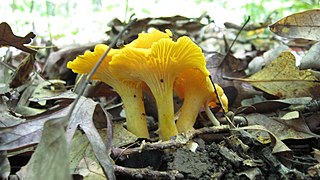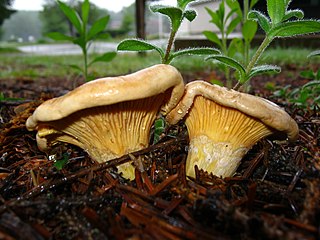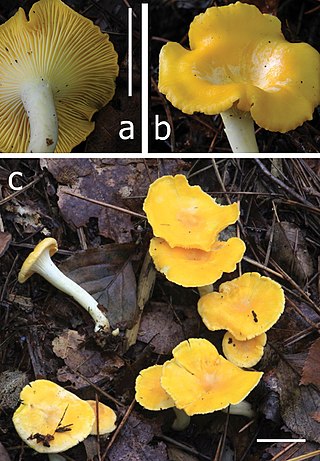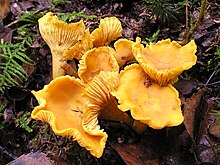
Chanterelle is the common name of several species of fungi in the genera Cantharellus, Craterellus, Gomphus, and Polyozellus. They are orange, yellow or white, meaty and funnel-shaped. On the lower surface, most species have rounded, forked folds that run almost all the way down the stipe, which tapers down from the cap. Many species emit a fruity aroma and often have a mildly peppery taste.

The Cantharellaceae are a family of fungi in the order Cantharellales. The family contains the chanterelles and related species, a group of fungi that superficially resemble agarics but have smooth, wrinkled, or gill-like hymenophores. Species in the family are ectomycorrhizal, forming a mutually beneficial relationship with the roots of trees and other plants. Many of the Cantharellaceae, including the chanterelle, the Pacific golden chanterelle, the horn of plenty, and the trumpet chanterelle, are not only edible, but are collected and marketed internationally on a commercial scale.

Cantharellus is a genus of mushrooms, commonly known as chanterelles, a name which can also refer to the type species, Cantharellus cibarius. They are mycorrhizal fungi, meaning they form symbiotic associations with plants. Chanterelles may resemble a number of other species, some of which are poisonous.

Craterellus cornucopioides, or horn of plenty, is an edible mushroom. It is also known as the black chanterelle, black trumpet, trompette de la mort (French), trompeta de la mort (Catalan) or trumpet of the dead, djondjon (Haitian).

Hygrophoropsis aurantiaca, commonly known as the false chanterelle, is a species of fungus in the family Hygrophoropsidaceae. It is found across several continents, growing in woodland and heathland, and sometimes on woodchips used in gardening and landscaping. Fruit bodies (mushrooms) are yellow–orange, with a funnel-shaped cap up to 8 cm across that has a felt-like surface. The thin, often forked gills on the underside of the cap run partway down the length of the otherwise smooth stipe. Reports on the mushroom's edibility vary – it is considered poisonous, but has historically been eaten in parts of Europe and the Americas.

David Arora is an American mycologist, naturalist, and writer. He is the author of two popular books on mushroom identification, Mushrooms Demystified and All That the Rain Promises and More....

Craterellus tubaeformis is an edible fungus, also known as yellowfoot, winter mushroom, or funnel chanterelle. It is mycorrhizal, forming symbiotic associations with plants, making it very challenging to cultivate. It is smaller than the golden chanterelle and has a dark brown cap with paler gills and a hollow yellow stem. C. tubaeformis tastes stronger but less fruity than the golden chanterelle. It has a very distinctive smokey, peppery taste when raw. It grows in temperate and cold parts of Northern America and Europe, including Scandinavia, Finland, Russia, and the British Isles, as well as in the Himalayas in Asia, including Assam, in the central parts of the Indian subcontinent, and in Thailand.

Polyozellus is a fungal genus in the family Thelephoraceae, a grouping of mushrooms known collectively as the leathery earthfans. Previously considered a monotypic genus, it now contains the Polyozellus multiplex species complex. The genus name is derived from the Greek poly meaning many, and oz, meaning branch. It is commonly known as the blue chanterelle, the clustered blue chanterelle, or, in Alaska, the black chanterelle. The distinctive fruit body of this species comprises blue- to purple-colored clusters of vase- or spoon-shaped caps with veiny wrinkles on the undersurface that run down the length of the stem.

Cantharellus lateritius, commonly known as the smooth chanterelle, is a species of edible fungus in the mushroom family Cantharellaceae. The species has a complex taxonomic history, and has undergone several name changes since its first description by American mycologist Lewis David de Schweinitz in 1822. The fruit bodies of the fungus are brightly colored yellow to orange, and usually highly conspicuous against the soil in which they are found. At maturity, the mushroom resembles a filled funnel with the spore-bearing surface along the sloping outer sides. The texture of the fertile undersurface (hymenium) of the caps is a distinguishing characteristic of the species: unlike the well-known golden chanterelle, the hymenium of C. lateritius is much smoother.

Cantharellus formosus, commonly known as the Pacific golden chanterelle, is a fungus native to the Pacific Northwest region of North America. It is a member of the genus Cantharellus along with other popular edible chanterelles. It was distinguished from the similar C. cibarius of Europe in the 1990s. It is orange to yellow, meaty and funnel-shaped. On the underside of the smooth cap, it has gill-like ridges that run down onto its stipe, which tapers down seamlessly from the cap. The false gills often have a pinkish hue. It has a mild, sweet odor. It is solitary to gregarious in coniferous forests, fruiting from July to December.

Cantharellus subalbidus, the white chanterelle, is a fungus native to California and the Pacific Northwest region of North America. It is a member of the genus Cantharellus along with other popular edible chanterelles. It is similar in appearance to other chanterelles except for its cream to white color and orange bruising.

Cantharellus californicus, also called the California golden chanterelle, mud puppy, or oak chanterelle, is a fungus native to California, United States. It is a member of the genus Cantharellus along with other popular edible chanterelles. It is generally similar in appearance to C. cibarius and C. formosus except for its large size at maturity.

Cantharellus cascadensis, the Cascade chanterelle, is a fungus native to the Pacific Northwest region of North America. It is a member of the genus Cantharellus along with other popular edible chanterelles. It is named after the Cascade Range, where it was formally described in 2003. It is considered a choice edible mushroom.

Cantharellus flavus, also called the American golden chanterelle, Eastern yellow chanterelle or Midwestern yellow chanterelle, is a species of fungus in the genus Cantharellus. Found in North America, it was described in 2013 by Matthew Foltz and Tom Volk. It is considered a choice mushroom. Its epithet flavus comes from the Latin word for "yellow", referring to this species' yellow spore print, stipe, false gills and cap.

Cantharellus lewisii is a species of fungus in the family Cantharellaceae.

Afrocantharellus is a subgenus of fungi in the genus Cantharellus. Species in this genus is found in Africa and China.

Cantharellus enelensis is one of several species of chanterelle native to North America. It is a new member of the C. cibarius complex and wasn't discovered until 2017. Chanterelles identified with DNA sequencing as C. enelensis have been found in Newfoundland, Quebec, Michigan and Illinois but there is evidence to suggest it is widespread in North American conifer forests. It has been temporarily categorized as having a conservation status of 'least concern'. Members of the C. cibarius complex in eastern North America are difficult to distinguish from one another without special techniques such as DNA sequencing and microscopic examinations. C. enelensis is the most commonly found chanterelle in Newfoundland. C. enelensis is one of 40 varieties of Cantharellus that grows in North America.

Cantharellus anzutake, also known as Japanese golden chanterelle, is a fungus native to Japan and Korea. It is a member of the genus Cantharellus along with other popular edible chanterelles. It is named after the Japanese common name of chanterelle, anzutake (杏茸).

Parvocantharellus is a subgenus of fungi in the genus Cantharellus. Species in this subgenus are found in North America, Asia and Africa.

Cantharellus iuventateviridis is a species of Cantharellus found in North America.




















